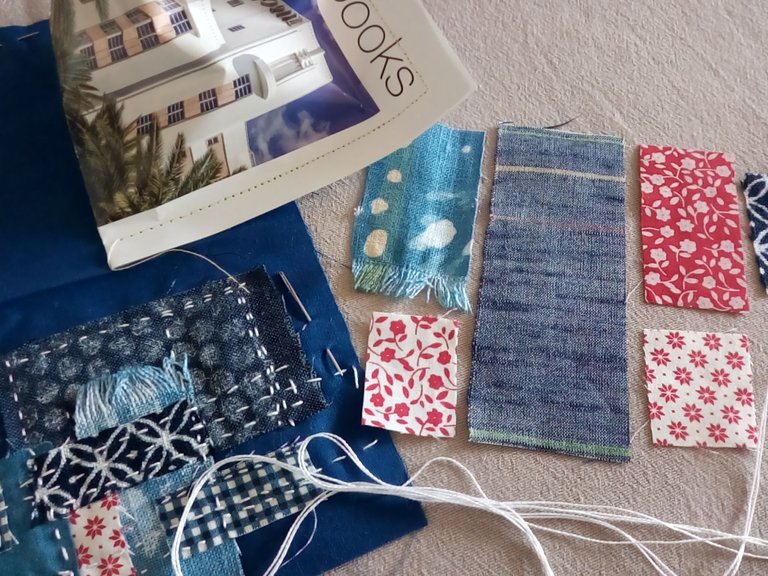
Samples of Boro lavender bags made by Jane Stock, who gave a talk and workshop to my sewing group last Thursday.
My sewing group is getting back into the swing of things after a long closure due to the pandemic. We have twenty-four paid up members now, plus guests can visit and take part for a small fee. This month, Jane Stock, a member of the Visualise Textile Group, gave a short introduction to Boro and Sashiko and ran a workshop where we tried out some of the techniques by making a small lavender bag. All in two hours (plus time for a cup of tea and catching up with people).
Boro is more of a philosophy than a technique - the recycling of fabrics and the conservation of garments to prolong their life. When a garment becomes worn, small patches are applied with hand-stitching, sometimes patches over patches, as wear tends to be in the same place. Garments become the fabric of life and family history. Layers are also held together with stitching to create additional warmth.
Small running stitches are used for boro and traditionally done with white thread on indigo naturally dyed natural fibres - linen and hemp and, sometimes, cotton, for everyday wear. What I liked was that the patches are not hemmed, they are attached with raw edges, with the repeated lines of running stitch creating the strength and durability of the patch and preventing fraying.
I would describe Sashiko as an elaboration of Boro (perhaps @akipponn can help me here 😍) where the stitching becomes more elaborate and forms patterns rather than a criss-cross grid. I loved the sentiments behind the techniques: "favouring the modest", "acceptance of imperfection and incompletion" and "regret of waste".

Jane brought wonderful examples of her work and her sketchbooks were fascinating - beautiful works of art in their own right.
Jane describes her work like this:
I am particularly drawn to materials and textiles that have had a previous life and show signs of wear and repair. Different processes include hand stitch, printing and dyeing. Indigo is a favourite and I am fascinated by the various patterns and effects that can be produced. My hand stitching is all about mark making rather than precision or regularity. (Source)
The group that Jane belongs to, VISUALise, uses mentors to work with the textile artists in the group to develop their practice:
The role of the mentor is to engage each practitioner in a dialogue with themselves - to propose not to impose. Rather than a full-stop, finished work is to be seen more as a comma, a pause for breath and reflection within the dialogue. (Source)
That seemed like a great idea and benefit to me - the opportunity to reflect on your work and time and space to think about where you are going and how you are progressing. I wonder if we could develop such a thing through Needlework Monday?

After Jane's talk we had a chance to try some of the techniques ourselves. All the materials were provided including home-made paper-bags full of lavender! It was lovely, like the little goodie bags we used to get at children's parties. Here I've attached (artistically) arranged fabric scraps, prior to the repeated lines of stitching that creates the repair. Some of the indigo-dyed scraps on the right were re-cycled table cloths and napkins.
We'd been asked to bring a basic sewing kit: I forgot. But then, I was at a loss as I had given away all my embroidery things at the last meeting and wouldn't have had any suitable needles (large eye, sharp point). Luckily, I was able to liberate a needle from another member.
Although some of the fabric we were working with was re-cycled, some of it was new and I did find that a bit strange and, in a way, uncomfortable. These were ancient traditions, embedded in a way of life and made beautiful by necessity. Yet, here we were in Market Harborough, in one of the most affluent districts in England, using these techniques as decoration and entertainment.
I reconciled myself that I was learning new techniques that could be applied as they were intended - to repair and extend the life of garments. And actually, I had a repair that needed doing: a small hole had appeared in my leggings at about the point where the zip on my boots ends. I haven't decided whether to patch them in blue or red ... and I wondered about a woven patch on a knitted fabric. We'll see.

My finished lavender cushion. I like the way the stitching merges everything together as if it is one fabric. There is a small piece of wadding on the back which helps to stabilise the work and the stitching through several layers and the padding creates a fabric that feels very dense. In spite of my misgivings while I was making it, I like the finished article.
I think my piece is much more worked than the examples at the beginning. I liked Jane's comment about "My hand stitching is all about mark making rather than precision or regularity". That's true of me, too.


Three things newbies should do in their first week and, for most things, forever afterwards!










